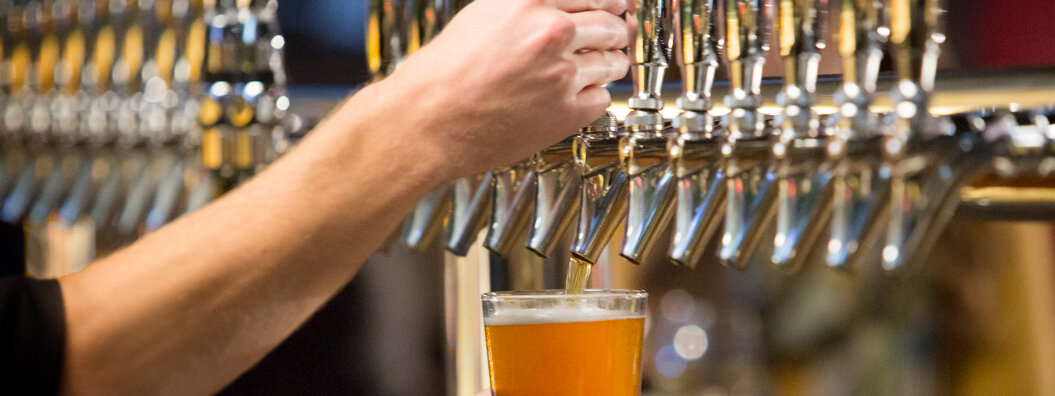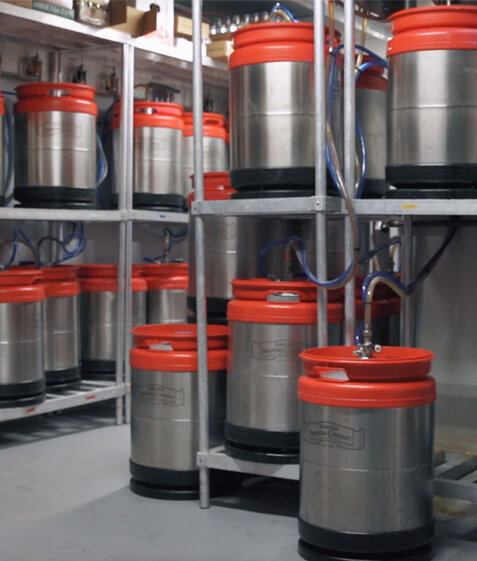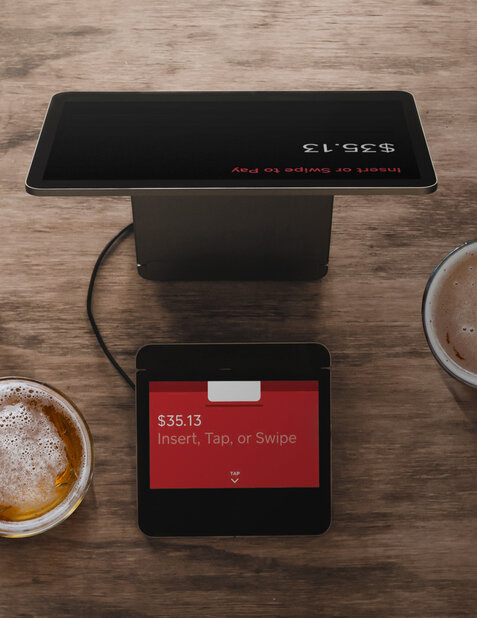Why Choose Draft
over Bottles or Cans?
People will always have different preferences and opinions when it comes to beer. With so many options available in the beer world, you could spend months discussing the wonders of IPAs, porters, stouts, or blonde ales.
That said, no matter what style of brew makes you happy, there is one common denominator across all these options: serving draft beer out of stainless steel kegs has proven to be preferable to traditional packaging every day of the week. Draft delivery not only provides the utmost in beer freshness, it also provides an unrivaled drinking experience by offering the "best of the brewers art." Simply put, draft beer provides superior economic and environmental benefits that traditional beer packaging does not.
With that in mind, we can compare common beer packaging, dispensing, and storage options to see how draft delivery outweighs them all in terms of overall benefits.
Bottles vs. Cans: Considerations to Keep in Mind
All the different styles of beer are impacted by the way it’s stored and dispensed. This occurs in a variety of ways. When analyzing the use of bottles and cans in the context of user experience and industry sustainability, there are some important considerations to keep in mind.
Portability
Bottles and cans are both very portable thanks to those handy six packs, 12-packs, and even 24+ packs. When it comes to ease of transportation, you could argue that cans are the winner. In fact, a 24-pack of bottled beer weighs almost twice as much as a 24-pack of the same canned variety.
While this may not be a problem when going to the beach with friends, it quickly becomes an operational issue at the commercial/retail level. It also makes things more difficult for employees to transport the beverages to serving stations. This is before having to worry about any breakage during transit.
Ease of Opening
Both cans and some bottles can be opened easily, but certain bottles come with unique frustrations when comparing both options. Many upscale offerings do not feature a twist-off top. You will need an opener unless you want to break a tooth or lose a nail. Canned offerings of the same product are the clear winner in this category.
Flavor and Freshness
Cans and bottles can impact the flavor, freshness, and overall quality of the beer in three key areas:
- Material: Aluminum will keep the beverage inside colder and longer than glass bottles. Another issue with bottles is that different types of glass may allow too much light to seep through (read about sunlight exposure below). The darker glass will help to protect the beer from this, but ultimately it can still affect the product’s quality.
- Lid: Cans are sealed hermetically. Although you might assume the same for bottles, bottle caps allow minute amounts of oxygen to seep through.
- Lining: Beer cans are lined inside to prevent the beer from coming into contact with the metal. This means that regardless of what type of can the beer is stored in, it’ll never affect its flavor.
The important question is, how does this compare to draft beer stored in kegs? Why is it that a freshly poured glass of draft beer simply just tastes better?
Sustainability and Environmental Impact
The unfortunate truth of any convenience provided by both glass bottles and aluminum cans is that, in many cases, they become single-use items, so that they can be detrimental to the environment. The EPA’s research found some interesting numbers about recycling and landfilling:
- A staggering 55% of glass containers were landfilled in 2018, with just 31% recycled.
- An estimated 50% of aluminum beverage cans were recycled in 2018.
This is proof that while recycling is always a good option for glass and cans, it is dependent on end users to ensure these packaging options are not contributing to a waste problem.

Why Does Draft Beer Taste Better?
Freshness is of the utmost importance when it comes to taste. Typically keg beer is consumed closer to the time that it leaves the brewery than bottled beer. This important benefit is just one of the advantages of draft beer delivery. Other significant advantages are:
No Oxidation
Beer is brewed with natural ingredients (e.g., hops, malts, and yeast). These ingredients are prone to oxidation which negatively impacts taste. Kegs contain less air than cans and bottles, which means the beverage inside retains its quality and fresh taste longer.
No Pasteurization Means a Cold Delivery
Domestic beer that is intended for bottling undergoes a pasteurization process. The finished brew is heated to kill off any bacteria that may grow between bottling and the time of consumption. This process compromises the original flavor.
Domestic keg beer does not require pasteurization and is kept consistently cool from the brewery to the distributor to the local tavern. In fact, most domestic kegs are kept cold until the tap is opened and poured into the glass. This ensures the intended flavor is retained.
No Sunlight Exposure
Sunshine can be fun if you’re visiting Florida from the northeast. Unfortunately, exposing glass bottles directly to sunlight is a bad idea. This is because sunlight causes a reaction within the hops that alters their taste, making the beer bitter. This outcome is easily preventable by storing beer in kegs. However, kegs aren’t a magical solution. You still have to do your part to keep beer keg lines clean, since failing to do so can also affect the taste of the beer.
A best practice is to clean beer lines every two weeks. This is the standard set by the industry trade group Brewers Association.
Draft Beer and Sustainability: The Environmentally Friendly Choice
When it comes to both taste and beverage experience, we've already established that draft beer is a far superior option, but did you know that ordering draft beer served out of stainless steel kegs is the most environmentally friendly choice available to beer lovers today? Fact: The draft beer keg has a service life of over three decades. Being reusable, this significantly reduces the number of beer cans and bottles that end up in landfills and the oceans. When a stainless steel keg has reached the end of its lifespan, it can be recycled, making the use of draft beer kegs the most sustainable and responsible option.

The beer industry as a whole is doing its part by promoting the use of this beverage storage solution. This is the mission of the nonprofit organization, the Steel Keg Association, whose efforts are backed up by Deloitte’s new ISO-14040 framework Life Cycle Analysis. “Steel kegs are truly one of the best examples of reusability and circularity, with decades of reuse potential,” said Kyle Tanger, Managing Director in Deloitte’s U.S. sustainability practice. “In the U.S. compared to single-use containers, steel kegs save over 400,000 metric tons of greenhouse gases (GHGs) and keep roughly 500,000 tons of packaging out of landfills each year.”
The Steel Keg Association is not alone in these efforts. Starbucks is also attempting to transition from using disposable paper and plastic cups to reusable options. As of this writing, they are testing different programs and approaches to reduce their waste substantially.
In a similar effort, Coca Cola has pledged to have at least 25% of their beverages sold globally delivered in reusable or returnable containers. This is coupled with a campaign to reduce their carbon footprint.
Regardless of industry, businesses will always strive to make a profit. The Steel Keg Association effectively highlights the profitability of making the switch.
Draft Beer Yields a Higher Return on Investment
Offering draft beer provides restaurant and bar owners with the opportunity to increase profits in a variety of ways.

Higher Profit Margin and Better Pour Cost
Although draft beer has a higher operating cost than bottled or canned beers, it is the highest margin menu item for restaurants and affords a slightly lower pour cost overall (bottled beer sits around 25%, draft beer sits close to 20%).
Better Quality
Since draft beer sells faster, kegs will be replaced regularly, guaranteeing the freshest product. If the beverages you serve are consistently fresh, crisp, and in optimal taste, word will quickly spread, and people will return. Additionally, kegs with blended gas ensure consistent pour quality every time you serve a glass, just as the brewer intended.
More Offerings
Many bars and restaurants feature an extensive number of draft beers as a way to stand out from the crowd. It’s a lot easier to do so when using long-draw systems that enable serving multiple options at once.
Better Customer Experience
One thing that makes people comfortable trying new beer products is the ability to taste before buying. In addition to offering beer flight options on your menu, serving beer on tap enables you to offer samples as part of your customer experience.
Find a Customized, Sustainable Dispensing Solution for Your Commercial Bar
For over 60 years, Micro Matic has been recognized as one of the world’s leading suppliers of draft beer equipment. Specializing in keg-to-glass technology, we offer a total solution for meeting your draft beer equipment needs. Our dedication to customer service is supported by four regional sales and distribution centers, the Micro Matic Dispense Institute for training and education, and a Certified Installer Network for draft beer installations. Want to speak with a “perfect pour” expert? Contact Micro Matic today.